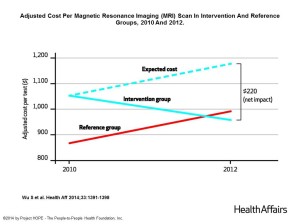 In the post-Recession American economy, people shop for value in all things. And that includes health care services like MRIs — when patients are informed of pricing differences among imaging facilities and given free rein to pick-and-choose among them. In addition to lowering imaging costs in a community, price transparency also generated competition between providers. Health Affairs published this research detailed in Price Transparency for MRIs Increased Use of Less Costly Providers And Triggered Provider Competition in August 2014. An Economics 101 course teaches us that a well-oiled (perfect) market depends on lots of sellers of a product and lots of buyers who can judge between different products based on information: price, quality, and other attributions. That information helps consumers make informed decisions: sorry for the tautology, but it is what it is. And so, even though economists can argue health care can never be a perfect market by definition (after all, there’s lots of complicated science and black boxes behind the curtain, and insurance limits “infinite” choice), a little price transparency can go a long way in arming people with, at a minimum, a menu of options before making the choice across a range of health providers. Sze-jung Wu and colleagues write about huge price variations for imaging services due to several factors that (my words) distort the market: a key variable is the nature of the facility, whether freestanding vs. hospital based or physician office, where hospitals often charge higher rates, especially among academic medical centers. It is the dawning age of price transparency, with “promising signs” beginning to emerge, Wu et. al. say. They reference a study on reference-based purchasing for Anthem Blue Cross and CalPERS, the California Public Employees’ Retirement Systems which incorporated reference-based pricing with outreach to members informing them about lower-cost facilities for elective surgery (see the study here). The secret in the sauce for the Health Affairs study is that the researchers’ intervention included outreach to members when they were scheduling an imaging procedure. This moved the initiative from a “passive,” put information up online and assume people will come (the Field of Dreams Effect), to nudging people toward patient and health financial activation.
In the post-Recession American economy, people shop for value in all things. And that includes health care services like MRIs — when patients are informed of pricing differences among imaging facilities and given free rein to pick-and-choose among them. In addition to lowering imaging costs in a community, price transparency also generated competition between providers. Health Affairs published this research detailed in Price Transparency for MRIs Increased Use of Less Costly Providers And Triggered Provider Competition in August 2014. An Economics 101 course teaches us that a well-oiled (perfect) market depends on lots of sellers of a product and lots of buyers who can judge between different products based on information: price, quality, and other attributions. That information helps consumers make informed decisions: sorry for the tautology, but it is what it is. And so, even though economists can argue health care can never be a perfect market by definition (after all, there’s lots of complicated science and black boxes behind the curtain, and insurance limits “infinite” choice), a little price transparency can go a long way in arming people with, at a minimum, a menu of options before making the choice across a range of health providers. Sze-jung Wu and colleagues write about huge price variations for imaging services due to several factors that (my words) distort the market: a key variable is the nature of the facility, whether freestanding vs. hospital based or physician office, where hospitals often charge higher rates, especially among academic medical centers. It is the dawning age of price transparency, with “promising signs” beginning to emerge, Wu et. al. say. They reference a study on reference-based purchasing for Anthem Blue Cross and CalPERS, the California Public Employees’ Retirement Systems which incorporated reference-based pricing with outreach to members informing them about lower-cost facilities for elective surgery (see the study here). The secret in the sauce for the Health Affairs study is that the researchers’ intervention included outreach to members when they were scheduling an imaging procedure. This moved the initiative from a “passive,” put information up online and assume people will come (the Field of Dreams Effect), to nudging people toward patient and health financial activation.  Health Populi’s Hot Points: What a novel concept: give people information which evens up the knowledge symmetry, give them power to vote with their feet and pocketbook, and let the best (or at least best-liked) providers compete and win in the marketplace. That’s straight out of Econ 101. Now we have data to back up the theory. Think about how posting calories on restaurant menus can build mindfulness in picking-and-choosing between that Monster Burger at Red Robin or the restaurant’s much healthier option, the Ensenada Chicken Platter. Transparency helps balance the information asymmetry that prevents people from being true health consumers, but also builds smart health shopping behavior. A differentiator in this program was also the consumer outreach – bringing a social support dimension to health. There are millions of web pages devoted to health information, and a growing roster of price and quality report cards in health. But consumer adoption of these portals and tools has been spotty. So having navigators and social support programs that help people understand the availability and utility of these sites made a statistically significant difference in this program.
Health Populi’s Hot Points: What a novel concept: give people information which evens up the knowledge symmetry, give them power to vote with their feet and pocketbook, and let the best (or at least best-liked) providers compete and win in the marketplace. That’s straight out of Econ 101. Now we have data to back up the theory. Think about how posting calories on restaurant menus can build mindfulness in picking-and-choosing between that Monster Burger at Red Robin or the restaurant’s much healthier option, the Ensenada Chicken Platter. Transparency helps balance the information asymmetry that prevents people from being true health consumers, but also builds smart health shopping behavior. A differentiator in this program was also the consumer outreach – bringing a social support dimension to health. There are millions of web pages devoted to health information, and a growing roster of price and quality report cards in health. But consumer adoption of these portals and tools has been spotty. So having navigators and social support programs that help people understand the availability and utility of these sites made a statistically significant difference in this program.  Consumers say they want this information: but growing the new muscles as health shoppers will take some mentoring and the tincture of time. Listen to Smokey: You’d Better Shop Around…
Consumers say they want this information: but growing the new muscles as health shoppers will take some mentoring and the tincture of time. Listen to Smokey: You’d Better Shop Around…
And for more on transparency in health care, see my “Season of Healthcare Transparency” blog posts:
Part 1 – HFMA’s Price Transparency Manifesto
Part 2 – Shopping in a World of High Cost and High Variability
Part 3 – Will Your Health Plan Be Your Transparency Partner?
Part 4 – Consumer Payments and Tools
Part 5 – Chaos, Then Creation




 I am so grateful to Tom Lawry for asking me to pen the foreword for his book, Health Care Nation,
I am so grateful to Tom Lawry for asking me to pen the foreword for his book, Health Care Nation,  I love sharing perspectives on what's shaping the future of health care, and appreciate the opportunity to be collaborating once again with Duke Corporate Education and a global client on 6th May. We'll be addressing some key pillars to consider in scenario planning such as growing consumerism in health care, technology (from AI to telehealth), climate change, and trust -- the key enabler for health engagement or dis-engagement and mis-information. I'm grateful to be affiliated with the corporate education provider
I love sharing perspectives on what's shaping the future of health care, and appreciate the opportunity to be collaborating once again with Duke Corporate Education and a global client on 6th May. We'll be addressing some key pillars to consider in scenario planning such as growing consumerism in health care, technology (from AI to telehealth), climate change, and trust -- the key enabler for health engagement or dis-engagement and mis-information. I'm grateful to be affiliated with the corporate education provider  Thank you FeedSpot for
Thank you FeedSpot for